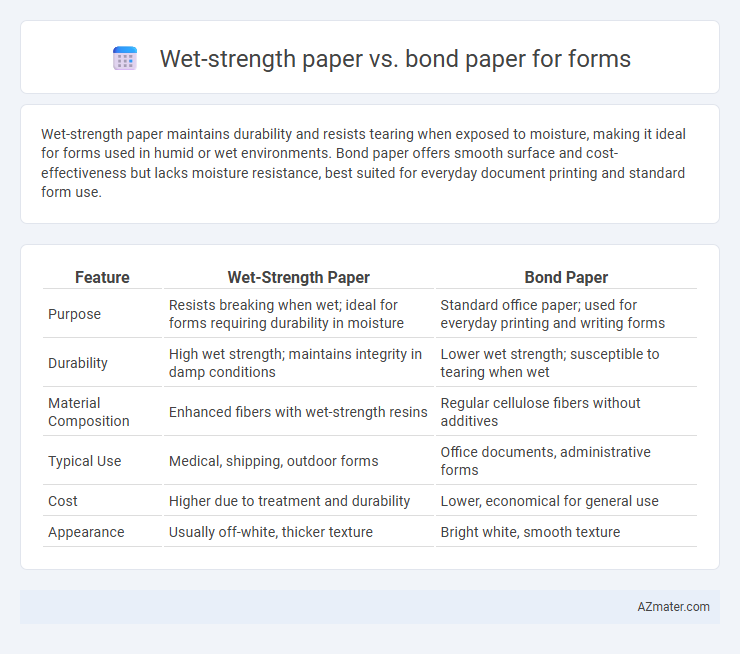Wet-strength paper maintains durability and resists tearing when exposed to moisture, making it ideal for forms used in humid or wet environments. Bond paper offers smooth surface and cost-effectiveness but lacks moisture resistance, best suited for everyday document printing and standard form use.
Table of Comparison
| Feature | Wet-Strength Paper | Bond Paper |
|---|---|---|
| Purpose | Resists breaking when wet; ideal for forms requiring durability in moisture | Standard office paper; used for everyday printing and writing forms |
| Durability | High wet strength; maintains integrity in damp conditions | Lower wet strength; susceptible to tearing when wet |
| Material Composition | Enhanced fibers with wet-strength resins | Regular cellulose fibers without additives |
| Typical Use | Medical, shipping, outdoor forms | Office documents, administrative forms |
| Cost | Higher due to treatment and durability | Lower, economical for general use |
| Appearance | Usually off-white, thicker texture | Bright white, smooth texture |
Overview of Wet-Strength Paper and Bond Paper
Wet-strength paper offers enhanced durability and resistance to water, making it ideal for forms exposed to moisture or handling in humid environments. Bond paper is a smooth, lightweight, and affordable option commonly used for everyday printing and copying, best suited for standard forms without exposure to wet conditions. The primary distinction lies in wet-strength paper's superior fiber reinforcement, which maintains integrity after water exposure, unlike bond paper which tends to weaken or tear.
Composition and Manufacturing Differences
Wet-strength paper incorporates chemical additives such as polyamide-epichlorohydrin resins during manufacturing, enhancing its resistance to water without compromising tear strength, making it ideal for forms exposed to moisture. Bond paper is primarily composed of wood pulp fibers and is produced through a refined paper-making process focused on smoothness and durability, but it lacks water-resistant additives, resulting in lower wet strength. The manufacturing process for wet-strength paper involves an additional curing stage to fix the wet-strength resins, whereas bond paper undergoes standard pressing and drying methods without chemical reinforcement.
Strength and Durability Comparison
Wet-strength paper features enhanced fiber bonding through chemical additives, significantly increasing its resistance to tearing and disintegration when exposed to moisture, making it ideal for forms in humid environments. Bond paper, composed of high-quality cotton or wood pulp fibers without special wet-strength additives, offers moderate strength and durability suitable for everyday signage and office forms but can weaken and tear easily under wet conditions. For applications demanding prolonged exposure to moisture or handling in damp conditions, wet-strength paper outperforms bond paper by maintaining structural integrity and legibility.
Water Resistance and Performance
Wet-strength paper exhibits superior water resistance compared to bond paper, making it ideal for forms exposed to moisture or handling in damp environments. Its enhanced fiber bonding prevents disintegration and maintains structural integrity even when wet, ensuring the legibility and durability of printed information. In contrast, bond paper offers lower water resistance, making it less suitable for forms requiring exposure to water or high humidity.
Printability and Surface Finish
Wet-strength paper offers superior durability and resistance to moisture, making it ideal for forms exposed to wet conditions or frequent handling. Bond paper provides excellent printability with a smooth, consistent surface finish that enhances text clarity and color vibrancy for high-quality forms. The choice between wet-strength and bond paper depends on the required durability versus the need for sharp, professional appearance in printed forms.
Applications in Form Production
Wet-strength paper offers superior durability and resistance to moisture, making it ideal for forms exposed to damp environments or handling with wet hands. Bond paper, favored for its smooth texture and affordability, is commonly used in standard office forms requiring crisp print quality and easy writing surface. For form production, selecting wet-strength paper ensures longevity in harsh conditions, while bond paper supports everyday transactional and administrative applications.
Environmental Considerations
Wet-strength paper incorporates chemicals such as polyamide-epichlorohydrin resins that enhance durability in moisture-prone environments but may pose challenges for recycling due to chemical residues. Bond paper, typically made from uncoated wood pulp fibers, offers easier recyclability and biodegradability, reducing environmental impact during disposal. Selecting bond paper over wet-strength paper supports sustainability goals by minimizing chemical use and simplifying waste management in forms production.
Cost Implications and Availability
Wet-strength paper generally costs more than bond paper due to the additional resins used to enhance durability in moist conditions, making it ideal for forms exposed to water or humidity. Bond paper is widely available and less expensive, suitable for everyday forms that do not require moisture resistance, resulting in lower overall material costs. Availability of wet-strength paper may be limited to specialty suppliers, while bond paper is readily accessible through standard office supply channels.
User Experience and Handling
Wet-strength paper offers superior durability and resistance to moisture, making it ideal for forms exposed to water or humid environments, enhancing user confidence in handling and preserving document integrity. Bond paper, while smoother and often preferred for everyday printing and writing, lacks the moisture resistance and can become fragile or illegible when wet, potentially frustrating users during handling. Optimal form selection depends on balancing the need for moisture durability with ease of writing and printing, influencing the overall user experience and form longevity.
Choosing the Right Paper for Forms
Wet-strength paper offers enhanced durability and resistance to moisture, making it ideal for forms exposed to humid or wet environments. Bond paper, known for its smooth texture and affordability, suits everyday forms used in dry conditions or office settings. Selecting the right paper depends on the form's exposure to water, required longevity, and cost considerations.

Infographic: Wet-strength paper vs Bond paper for Form
 azmater.com
azmater.com